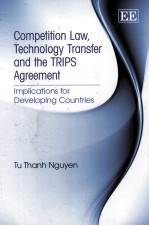图书介绍
COMPETITION LAWPDF|Epub|txt|kindle电子书版本网盘下载

- TECHNOLOGY TRANSFER AND THE TRIPS AGREEMENT 著
- 出版社: EDWARD ELGAR
- ISBN:1849801258
- 出版时间:2010
- 标注页数:346页
- 文件大小:17MB
- 文件页数:361页
- 主题词:
PDF下载
下载说明
COMPETITION LAWPDF格式电子书版下载
下载的文件为RAR压缩包。需要使用解压软件进行解压得到PDF格式图书。建议使用BT下载工具Free Download Manager进行下载,简称FDM(免费,没有广告,支持多平台)。本站资源全部打包为BT种子。所以需要使用专业的BT下载软件进行下载。如BitComet qBittorrent uTorrent等BT下载工具。迅雷目前由于本站不是热门资源。不推荐使用!后期资源热门了。安装了迅雷也可以迅雷进行下载!
(文件页数 要大于 标注页数,上中下等多册电子书除外)
注意:本站所有压缩包均有解压码: 点击下载压缩包解压工具
图书目录
1 Technology transfer and competition rules under the TRIPS Agreement1
1.1 Introduction1
1.1.1 Overview1
1.1.2 Principles of the TRIPS Agreement5
1.1.3 Effect of the TRIPS Agreement at the domestic law level7
1.2 The TRIPS Agreement and international technology transfer11
1.2.1 Property rules of IPRs11
1.2.1.1 Economic and legal justifications for IPRs11
1.2.1.2 Intellectual property protection: property rules v. liability rules18
1.2.2 IPRs and technology transfer24
1.2.3 Technology transfer-oriented provisions of the TRIPS Agreement28
1.3 The TRIPS Agreement and competition rules32
1.3.1 IPRs and competition law32
1.3.2 Pre-TRIPS Agreement39
1.3.3 Competition rules in the TRIPS Agreement42
1.3.3.1 Introduction42
1.3.3.2 Interpretation45
1.3.3.3 Overview of application and disposition52
1.4 Concluding remarks58
2 Application of competition law to technology transfer in developed countries - US and EU perspectives59
2.1 Background59
2.1.1 Introduction59
2.1.1.1 Development of the IP-antitrust law intersection in the US59
2.1.1.2 Development of the IP-competition law intersection in the EU64
2.1.2 Principles68
2.1.2.1 Anti-competitive agreements: per se rule and rule of reason68
2.1.2.2 Monopolization or abuse of a dominant position: a two-pronged test71
2.2 Anti-competitive price practices77
2.2.1 Royalty concerns78
2.2.1.1 Excessive royalties78
2.2.1.2 Post-expiration royalties82
2.2.1.3 Total sale royalties84
2.2.1.4 Remarks86
2.2.2 Restrictions on product prices86
2.3 Anti-competitive non-price practices90
2.3.1 Grantback90
2.3.2 Tying and package licensing92
2.3.3 Non-challenge clause97
2.3.4 Exclusivity in technology transfer agreements99
2.3.4.1 Exclusive licensing99
2.3.4.2 Exclusive dealing103
2.3.5 Output restrictions and other non-price restrictions104
2.4 Refusal to transfer technology105
2.4.1 Refusal to license in the US106
2.4.1.1 Trinko and traditional views106
2.4.1.2 Post-Trinko development: eBay and Credit Suisse109
2.4.1.3 Kodak, Xerox and others: a split among US courts of appeals114
2.4.1.4 Remarks118
2.4.2 Refusal to license in the EU119
2.4.2.1 Refusal to deal in the EU: introduction119
2.4.2.2 Volvo and Renault: initial cornerstones120
2.4.2.3 Magill, IMS Health and Microsoft v. Commission: new guidance121
2.4.2.4 Remarks128
2.5 Contractual restrictions on downstream purchasers128
2.5.1 US perspective129
2.5.1.1 Implications of Quanta129
2.5.1.2 Federal Circuit’s judgments revisited through the Quanta prism136
2.5.2 EU perspective145
2.5.2.1 Community exhaustion145
2.5.2.2 Contractual restrictions on downstream purchasers in the EU150
2.5.3 Remarks154
2.6 Compatibity with the TRIPS Agreement155
2.6.1 Arguments against TRIPS compatibility155
2.6.2 Arguments for TRIPS compatibility157
2.7 Concluding remarks159
3 Application of competition law to technology transfer in developing countries161
3.1 Background161
3.1.1 Overview161
3.1.2 Current models in developing countries166
3.1.2.1 Overview166
3.1.2.2 Normative models169
3.2 Certain specific cases174
3.2.1 Microsoft tying cases174
3.2.1.1 Microsoft Korea175
3.2.1.2 Microsoft Taiwan178
3.2.1.3 Microsoft Croatia179
3.2.1.4 Remarks180
3.2.2 Refusal to license pharmaceutical patents cases180
3.2.2.1 Background180
3.2.2.2 Hazel Tau v. GlaxoSmithKline and Boehringer Ingelheim184
3.2.2.3 TAC v. Bristol-Myers Squibb188
3.2.2.4 TAC v. MSD&Merck189
3.2.2.5 Remarks192
3.2.3 Abbott’s withdrawal of drug registration application199
3.2.3.1 Section 25(3) complaint200
3.2.3.2 Section 28 complaint202
3.2.3.3 Remarks202
3.2.4 Philips’ Taiwan package licensing case204
3.2.4.1 Background204
3.2.4.2 Other cases involved206
3.2.4.3 Remarks210
3.3 IPRs, technology transfer and competition law in Vietnam - a case study212
3.3.1 Background212
3.3.1.1 Overview212
3.3.1.2 IP law in Vietnam214
3.3.1.3 Competition law in Vietnam216
3.3.2 Technology transfer-related competition law issues in Vietnam226
3.3.2.1 From the perspective of IP law226
3.3.2.2 From the perspective of competition law230
3.3.2.3 Relevant cases233
3.3.3 Remarks243
3.4 Obstacles for developing countries244
3.4.1 Internal obstacles244
3.4.1.1 Lack of capacity244
3.4.1.2 Deficiency of legislation244
3.4.1.3 Absence of competition culture246
3.4.1.4 Lack of cooperation between competition authorities and IP authorities246
3.4.2 External obstacles247
3.4.2.1 Argentina-US mutually agreed solution247
3.4.2.2 Communications from the EC relating to the anti-monopoly law of China250
3.4.2.3 Bilateral agreements and TRIPS-plus standards251
3.5 Concluding remarks254
4 Prospects of technology transfer-related competition law in a global context256
4.1 Alternatives and challenges256
4.1.1 Enforcement outsourcing256
4.1.2 International cooperation between competition authorities260
4.1.3 Harmonization through international forums267
4.1.3.1 WTO267
4.1.3.2 OECD271
4.1.3.3 UNCTAD272
4.1.3.4 ICN273
4.1.3.5 Other international forums: WIPO and WHO274
4.1.3.6 Remarks275
4.2 Prospects for the technology transfer-related competition provisions of the TRIPS Agreement276
4.2.1 Over-enforcement and under-enforcement276
4.2.2 IPR-related trade and competition278
4.2.3 Dispute settlement280
4.3 Concluding remarks283
5 Implications for developing countries286
5.1 Purposes and principles286
5.2 General implications290
5.2.1 Importance of IPR-related competition law in technology transfer and economic growth292
5.2.2 Tailoring and enforcing domestic IPR-related competition law to suit particular socio-economic contexts293
5.2.3 Cooperation between competition authorities and IP authorities294
5.2.4 International cooperation in enforcement of IPR-related competition law294
5.2.5 Other general implications295
5.3 Specific implications296
5.3.1 Refusal to license297
5.3.2 Excessive pricing298
5.3.3 Tying299
5.3.4 Use restriction on downstream purchasers299
5.4. Summary and final remarks300
Bibliography303
Index327